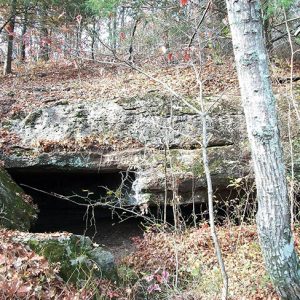calsfoundation@cals.org
Saltpeter Mining
Potassium nitrate, or saltpeter, is a naturally occurring mineral that is vital to the production of gunpowder. Found in limestone caves in the Arkansas Ozarks, it became one of the state’s most important chemical industries during the Civil War due to the Confederacy’s demand for arms. Although this resource was a definite advantage for the Confederacy, problems with labor, security, and transportation made Arkansas’s saltpeter mines an ultimate failure.
Saltpeter deposits were known by early Arkansas settlers long before the Civil War in Madison, Searcy, Independence, Marion, and Newton counties. A geographical survey was conducted by Dale David Owens from 1857 to 1860. His findings were published in 1860, and, by 1862, the Confederacy, looking to arm itself for the upcoming conflict, began funding the development of these resources. Between the time of secession and the outbreak of war, they purchased such materials from the Union, but after the attack on Fort Sumter on April 12, 1861, President Abraham Lincoln cut off trade with seceded states. Less than a month later, on May 6, the Arkansas Secession Convention voted to secede, and the Arkansas State Gazette urged that the state build up a supply of arms and munitions, maintaining that it had enough saltpeter to supply all of the Confederate forces. The Confederacy, in turn, had confidence in Arkansas’s production of the mineral.
As soon as it became known that the Confederacy was purchasing great amounts of saltpeter, private entrepreneurs moved into the area to exploit the resources. These operatives reported that the supply of saltpeter was “virtually inexhaustible,” and Arkansas’s deposits were especially advantageous because of their proximity to potash, wood, and water, which were essential to such operations. Major General Leonidas Polk suggested to Jefferson Davis, president of the Confederacy, that the caves be taken over and worked by the Confederate government. The saltpeter was shipped down the Arkansas River to New Orleans, Louisiana, until Admiral David G. Farragut’s capture of that city at the end of April 1862.
One of the major issues that faced saltpeter mining was the security of the operations. Similar mines in Tennessee and Virginia were not able to produce as much because they were too close to the Union front; likewise, the Arkansas Ozarks area was home to a great number of anti-secessionists who were hostile to the Confederacy. After the Confederate defeat at the Battle of Pea Ridge in March 1862, Union forces had easy access to the area, and, within a year after the start of the war, the North was successfully disrupting saltpeter mining in the area. Despite the fact that many of the largest caves had fallen under Union control, the Confederate government at Richmond, Virginia, was hesitant to move its operations to Texas because it would only worsen transportation difficulties. The Confederate Nitre and Mining Bureau was created to protect the mines and all of their employees, who were exempt from military service. Despite intrusion by Union forces, Rebel policy was to retreat as the enemy came near, and then return a few weeks later once the mine was safe again. This process kept the enormous operations under way.
This persistence kept mining going strong, helping the Confederate guerillas fight until the final days of the war. Another challenge, however, was finding employees to work the mines. Because personnel was a necessary part of the war effort, they could not be conscripted. Many slaves were also used, but the areas where the mines were—Searcy, Marion, and Newton counties—had unusually high numbers of free black citizens, who tipped off the Federals and were unsympathetic to the Confederate operations. Local labor was much more reliable, and, in 1863, stragglers and deserters in the military were forced to work in the mines.
Toward the end of the war, most saltpeter mining operations moved into Texas, and, by September 1863, the Nitre and Mining Bureau had left Arkansas. There was no decent means of transporting the resources from the area except for the White River, which took a great amount of effort to reach by teams of oxen. Even though the Confederate guerillas kept the mines up and running independently until the end of the war, saltpeter mining in Arkansas was ultimately considered a failure.
For additional information:
Johnston, James J. “Bullets for Johnny Reb: Confederate Nitre and Mining Bureau in Arkansas.” Arkansas Historical Quarterly 49 (Summer 1990): 124–167.
Kirk, Mrs. Elmer. “The Saltpeter Mine of 1862.” Independence County Chronicle 3 (April 1962): 3–9.
Bernard Reed
Little Rock, Arkansas
 Saltpeter Cave
Saltpeter Cave 



Comments
No comments on this entry yet.